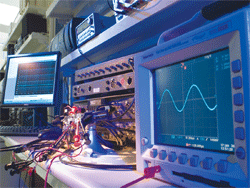National Semiconductor won the Product of the Year Award for its LM4562 dual audio op amp. We recently communicated with lead designer Matsuro Koterasawa and asked him about the development of the part.
The need
Audio performance levels have risen dramatically in the last 20 years. The last audio op amps were designed over 20 years ago. Their performance has not kept pace with the demands of the high-performance audio marketplace. Process technology has, however, continued to advance, making the potential for much higher performance, higher-definition audio op amps a reality. Most of this development effort has been targeted at markets other than audio.

Testing the LM4562
The amplifier’s designer was tasked with investigating whether or not such an amplifier could be created. The LM4562 leverages one of the company’s high-performance complementary bipolar transistor processes and updated design and simulation tools.
Balanced performance drove the design decisions. Vanishingly low THD+N and very-low-voltage noise density were the most important design targets. But achieving these targets was not done at the expense of the part’s superior linearity and dc performance. The LM4562’s performance was maximized by the careful design of each stage in the amplifier: the input stage, the second-stage voltage amplifier, and the output stage. Much consideration was given to how each stage interacted with, and influenced the operation of, the other stages.
Teamwork
The core product development team included Design, Applications, Test Development, Product Engineering, and Marketing. Additionally, there were contributions from Process Technology and the CAD group. The LM4562 was developed by National Semiconductor staff from Santa Clara, CA, Tokyo, Hong Kong, Texas, and Melaka, Malaysia.
Challenge/obstacle
The biggest challenge was establishing, fine-tuning, and maintaining the balanced operational performance between the LM4562’s three amplifier stages. Whereas there are amplifiers with lower-voltage noise density, they do not have the balanced performance found in the LM4562. Optimizing tradeoffs to achieve balanced performance is one of the most significant challenges for the amplifier designer. Balance was established between low input bias current, very low noise, high slew rate, high gain-bandwidth, and vanishingly low THD+N.
Christina Nickolas
Advertisement
Learn more about National Semiconductor





